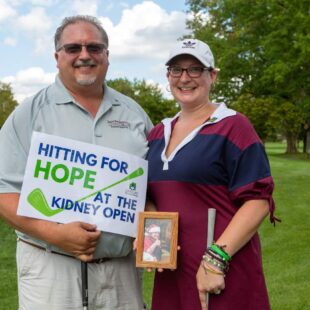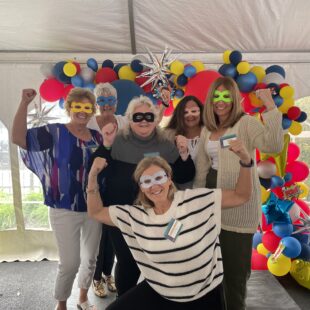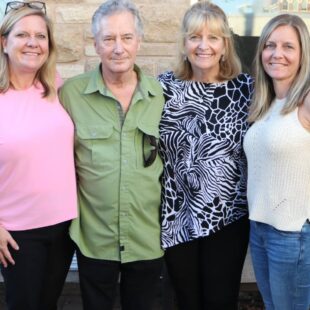Caregiver LifeLine Resources

By Talia Giordano, LCSW
Family Services and Caregiver Lifeline Program Manager
Taking on the role of a caregiver does not erase your original role as a spouse, parent, child or friend. Maintaining balance is key to avoiding the loss of your own identity. Here are key strategies:
1. Set Boundaries:
Clearly define what you can and cannot do as a transplant caregiver. Communicate our limits and seek help with tasks that cause stress, such as managing complex medical needs or providing emotional support during recovery. Setting boundaries can help prevent resentment and burnout.
2. Create a Transplant Care Plan:
Use a journal to organize caregiving tasks and appointments related to the transplant. Record medication schedules, doctor visits, and transplant care needs, especially post-transplant. This will help you identify when assistance is needed, schedule personal time, and manage responsibilities more effectively.
3. Take Personal Time:
Prioritize activities that bring you joy to maintain your well-being. Regular self-care is crucial for sustaining the stamina and emotional resilience required for transplant caregiving.
4. Nurture Relationships:
Set aside time away from caregiving to strengthen your bond, such as a date night with your spouse, quality time with your child, or meaningful conversations with a parent. Engage in activities that reinforce your original connection and maintain a sense of closeness.
5. Ask for Help:
Don’t hesitate to seek support from family, friends, or professionals such as transplant social workers or counselors. Take advantage of respite care from loved ones or in-home nursing aides to ease the demands of transplant caregiving and ensure you receive the emotional support you need. By preserving the core of your relationship and establishing clear boundaries, transplant caregiving can become a fulfilling experience rather than an overwhelming one.
Challenges for Transplant Caregivers in Different Relationships
As a Spouse:
Caregiving for a transplant patient can blur roles and create stress. To maintain intimacy and partnership, schedule “couple time” and ensure caregiving doesn’t dominate your interactions. Seek professional support for emotional guidance when needed, particularly if medical tasks or recovery begin to strain the relationship.
As a Parent:
Balancing caregiving for a child undergoing a transplant can be overwhelming. Encourage children to participate in age-appropriate activities to maintain a sense of normalcy. Involve them in decisions about their care to empower and reassure them throughout the process.
As a Son/Daughter:
Caring for aging parents after a transplant can be emotionally taxing. Work together to meet their daily needs while preserving their independence. Utilize transplant resources for financial and emotional support, and collaborate with healthcare providers to manage post-transplant care effectively.
As a Friend:
Caregiving for a friend undergoing a transplant can be challenging without familial authority. Maintain boundaries and remember to nurture the friendship beyond caregiving duties. Offer both practical and
emotional support while respecting their autonomy.
To talk with a social worker about resources and support around maintaining healthy relationships as a transplant caregiver, please reach out to Talia Giordano, LCSW at caregiverlifeline@giftoflifehowieshouse.org

By Talia Giordano, LCSW
Family Services and Caregiver Lifeline Program Manager
After working with transplant caregivers and families for over 13 years, one theme continues to emerge: transplant caregivers consistently reveal feelings of guilt. Caregivers can often experience guilt from maintaining ones own physical and emotional health, communicating openly with loved ones, and allowing oneself to experience happiness and joy. Such feelings of guilt can weigh heavily, inhibit positive coping mechanisms, and strain relationships.
As one transplant caregiver explained, “I occasionally feel guilt or resentment, not against anyone in particular but against the circumstances. I mourn the loss of what we had planned for the rest of our lives together and the fact that it has been replaced by our new normal. Still, I am grateful that we have the time that we have been given.”
Another caregiver stated, “The pressures of being a caregiver are often overwhelming. Caring for a loved one brings me mental and physical stress and worry of losing them. I have constant thoughts whether I am doing the right things for them. This significantly impacts doing essential things for myself and brings on additional concerns that someday I too will be in the same situation as the person I care for.”
Another type of guilt transplant caregivers may experience is centered around feeling that they should have done things differently.
A third caregiver recalls, “I went through a night of guilt last night, feeling upset and questioning why I didn’t do more. I imagine that if I had made different choices at the beginning, the outcome might have been different.”
Feelings of guilt cannot simply be “turned off” when one is told, “You shouldn’t feel that way.” Emotions such as guilt, sadness, or happiness can be supported and managed through positive coping tools. Instead of discouraging feelings of guilt in caregivers, these feelings should be normalized and validated, helping caregivers feel valued and maintain a sense of self-worth.
Self-care is imperative to managing stress and the burdens associated with caring for a loved one. Schedule self-care into your daily routine, like an appointment to help you feel more accountable. Self-care does not need to be an activity that lasts for hours; it could be a 15-minute walk outside, a 15-minute chair meditation, or a creative art or craft activity. Focus on activities that help you feel replenished – even if it is just for a few minutes.
Receiving support from others in similar situations can also be beneficial for caregivers. By participating in support groups with those who have similar experiences you can feel validated and appreciated for the feelings you are experiencing. You may also learn new tips and tools for navigating the caregiving and transplant process. The Caregiver Lifeline Program offers a virtual transplant caregiver support group twice a month that caregivers can join from anywhere in the world!
Finally, sometimes feelings of guilt, depression, and anxiety may be too overwhelming and cause a negative impact on daily functioning. If this is the case, speaking to a mental health professional is recommended. A mental health professional can work with transplant caregivers in developing and maintaining positive coping tools and long-term emotional wellness.
One transplant caregiver suggests, “…my advice to anyone in the process of receiving a donation [transplant] is make sure the patient and caregiver have counseling/psychiatric support before and after.”
To talk with a social worker about resources and support around caregiver guilt, emotional wellness, or support groups, please reach out to Talia Giordano, LCSW at caregiverlifeline@giftoflifefamilyhouse.org.

The Caregiver Lifeline Program is supported in part by TD Charitable Foundation. We are thankful for their partnership and generosity.
Caregiver Lifeline Spotlight

Transplant patients can live for many decades after transplantation, and with that remarkable success and progress comes a need for personalized and multidisciplinary medicine that includes specialized dermatology care.
Organ transplant recipients have an increased risk of skin cancer because immunosuppressive medications that prevent transplanted organs from being rejected by the body also lower the body’s natural defenses against skin cancer. The most common type of skin cancer in transplant patients is squamous cell carcinoma. The good news is that if detected early, with good care these cancers can be managed and very often cured.
Transplant Dermatologists have a simple goal – no one should die of skin cancer after a second chance at life through organ donation.
How high is the risk of skin cancer in transplant patients?
One in five people without a transplant will develop skin cancer by the age of 70. That story is dramatically different for transplant patients. Transplant patients are 65 times more likely to get squamous cell carcinoma than people without a transplant. They are 10 times more likely to get basal cell carcinoma, the least serious type of skin cancer. And transplant patients are 3 to 4 times more likely to develop melanoma, a potentially more serious type of skin cancer.
Skin cancers in transplant patients can grow quickly and have an increased risk of spreading. That’s why having a good relationship with a dermatologist who specializes in transplant dermatology can be game changing. Prompt and expert dermatologic care, which often includes a specialized type of surgery called Mohs surgery for certain skin cancers, is crucial for transplant patients.
What can transplant patients do about the increased risk of skin cancer?
The most important thing to do to lower the chance of skin cancer is sun protection – sunscreen, sun protective clothing, hats and sunglasses. Go ahead and make that hat fashion statement. As with many cancers, early detection of skin cancer is an important factor for preventing serious complications and death. Fortunately, most skin cancers can be easily treated in outpatient settings. The most common way to treat skin cancers in sensitive areas like the face is with Mohs Surgery. Mohs offers the highest cure rate and is the most precise way to treat skin cancer with the best cosmetic outcomes after surgery.
Good transplant dermatology care also offers treatments and medications to help lower the chance of developing skin cancer in the first place.
How often should you see a board-certified transplant dermatologist after an organ transplant?
What time and experience have proven is that routine dermatology care is an essential part of organ transplant care. Every transplant patient should be seen by a board-certified dermatologist around the time of transplantation, not because skin cancer is looming, but to start learning about skin cancer and what to look for.
After that, the frequency of dermatology visits will be based on each person’s unique situation. For some, visits are needed every few months. Fortunately most transplant patients do very well with visits to the dermatologist every 6 to 12 months.
If you are a transplant patient, talk to your transplant coordinators and physicians about finding a dermatologist who has an interest in transplant dermatology. You can also look for a transplant dermatologist through the International Immunosuppression & Transplant Skin Cancer Collaborative’s “Find a Transplant Dermatologist” tool.
Learn More About Transplant Dermatology
To learn more please watch Dr. Mark’s webinar presented through the Caregiver Lifeline Program

Many transplant patients and caregivers will miss out on holiday traditions, time with friends and family, and normal self-care practices due to the pandemic. This can cause increased feelings of isolation and stress during an already stressful time.
Self-care is critical during this time. Below are a few suggestions on how to manage the stressors you may face this season and ways to fight the winter-time and pandemic blues!
Prepare:
- Identify new traditions or modify old ones as a way to maintain some normalcy! For instance if you normally cook for a large group, maybe you can still prepare some of the meal and then make to-go containers for your friends or family to grab and go.
- Create a gift budget. Finances this year have been a struggle for most. Also consider handmade gifts or creative gifts to avoid over spending.
- Organize a special activity or event with friends and family for a later time when gatherings are safely approved again. This may help your family by having something to look forward to.
Prioritize Self-Care:
- Safely get outdoors. A little fresh air and movement each day can impact our bodies and minds in a great way!
- Find and participate in online groups or classes. As our society has adjusted to virtual gatherings, more online opportunities have been developed. Try finding your favorite support group, fitness class online, or an online class to learn a new skill.
- Be intentional. Try practicing mindfulness, deep breathing, or listening to your favorite feel good music once a day.
- Allow space for grief and loss. Do not minimize your grief this holiday. Allow yourself to experience it and talk about it with your support system.
- Be gentle with yourself. Recognize and reflect on what you have gone through this year and the changes you have adapted to.
- Practice gratitude. Take time to acknowledge the good. Remembering what we are thankful for can do wonders on any rainy (or snowy) day!
Connect:
- Use any form of communication and technology that you have access to & stay connected! For instance, keep regularly scheduled Zoom or Facetime calls with family and friends and put it on your calendar.
- Ask for help. If you are struggling or need support, reach out. Identify a support person or resource and express your needs.
RESOURCES: If you or someone you know needs additional support, please utilize and share the resources below:
- Caregiver Lifeline Program – support for transplant families: 267-546-9800
- Support with Mental and/or Substance Use: SAMSHA National Helpline 1-800-662-4357
- Domestic Violence: 1-800-799-SAFE
- National Suicide Prevention Hotline 800-273-8255
- Find Local Food Resources Near You: Philabundance.com / P: (215) 339-0900
- Veterans Crisis Line 1-800-273-8255.
By Faith Osbourne, MSW
Gift of Life Howie’s House Social Worker
Authors: Leora Aizman, BS; Thuzar M. Shin, MD
University of Pennsylvania High-Risk Skin Cancer Clinic for Organ Transplant Patients

Skin cancer occurs in one out of every five people,1 but solid organ transplant recipients are at a higher risk than the general population. Skin cancer is the most common cancer after transplant,2 affecting up to 70% of patients.3 Fortunately, this condition is potentially preventable and easily treated when caught early. The best ways to protect yourself are to understand your risks and follow practices to prevent the development and progression of skin cancer.
Transplant patients are at increased risk for skin cancer because immunosuppressive medications, which are necessary for the health of transplanted organs, decrease the body’s defenses against skin cancer. The longer recipients are taking immunosuppressive medications and the higher the dose, the more likely skin cancer is to develop.2,4 It is important to recognize that skin cancer also occurs at much younger ages in transplant recipients. They usually begin to develop five to seven years after a transplant, but may develop sooner in older patients2 or in patients who have had a skin cancer prior to transplant.5 Not all transplant recipients are affected equally. Heart transplant recipients, followed by kidney recipients, are the most likely to develop skin cancer.4

The three main types of skin cancer are: squamous cell carcinoma, basal cell carcinoma, and melanoma. Squamous cell carcinoma is the most common type of skin cancer in the transplant population and is 65-times more likely to occur in transplant recipients than in the general population.6 Squamous cell carcinomas appear as small pink spots with a scaly surface and usually develop on areas exposed to sunlight, such as the head, neck, and hands. Basal cell carcinomas frequently occur in similar locations, but look like shiny pink bumps or patches. Melanoma is the least common, but deadliest, form of skin cancer and usually appears as an irregularly-shaped brown spot or changing mole, often on the back or legs. All three types of skin cancers are curable if caught early, but may cause extensive local destruction and even death if left untreated.
There are a number of steps patients can take to reduce their risk of developing skin cancer. The transplant recipient is their own first line of defense. The first principle of skin protection is to avoid sun exposure and commercial tanning booths. Additional steps to minimize sun exposure include seeking shade, staying indoors during the hours of peak sunlight (10am-4pm), wearing sun-protective clothing (long-sleeved shirts and pants, broad-brimmed hats, sunglasses), and using a broad-spectrum sunscreen with SPF 30 or higher on exposed skin (which needs to be re-applied every 2 hours, sooner if you swim or sweat excessively). Monthly self-skin exams may help detect any new or changing growths or moles. This may be done by using a mirror to examine all parts of your body, including the palms, soles, and genitalia. In addition to self-skin exams, experts recommend a full-body skin examination with a board-certified dermatologist at least once a year.7 For very high-risk patients, even more frequent follow up with a dermatologist may be crucial to detecting and treating skin cancers early.
There are a variety of methods to treat skin cancer, including creams, scraping, and freezing for early cancers. More advanced cancers may require surgical removal. Mohs micrographic surgery is a special surgical procedure that removes skin cancer in layers, to preserve normal skin. For both treatment and prevention, skin care management should involve a close partnership between the patient and their transplant doctor and dermatologist.
References
1. Stern RS. Prevalence of a history of skin cancer in 2007: results of an incidence-based model. Arch Dermatol. 2010;146(3):279-282.
2. Mittal A, Colegio OR. Skin Cancers in Organ Transplant Recipients. Am J Transplant. 2017;17(10):2509-2530.
3. Bangash HK, Colegio OR. Management of non-melanoma skin cancer in immunocompromised solid organ transplant recipients. Curr Treat Options Oncol. 2012;13(3):354-376.
4. O’Reilly Zwald F, Brown M. Skin cancer in solid organ transplant recipients: advances in therapy and management: part I. Epidemiology of skin cancer in solid organ transplant recipients. J Am Acad Dermatol. 2011;65(2):253-261.
5. Garrett GL, Blanc PD, Boscardin J, et al. Incidence of and Risk Factors for Skin Cancer in Organ Transplant Recipients in the United States. JAMA Dermatol. 2017;153(3):296-303.
6. Perez HC, Benavides X, Perez JS, et al. Basic aspects of the pathogenesis and prevention of non-melanoma skin cancer in solid organ transplant recipients: a review. Int J Dermatol. 2017;56(4):370-378.
7. Crow LD, Jambusaria-Pahlajani A, Chung CL, et al. Initial skin cancer screening for solid organ transplant recipients in the United States: Delphi method development of expert consensus guidelines. Transpl Int. 2019;32(12):1268-1276.
Bridge to Life
TD Charitable Foundation
Ashley and Bobby were busy planning their wedding when Bobby became ill and required a double lung transplant. Quickly their lives were turned upside down. Ashley became a caregiver at just 27 and has learned how to manage the new life transplant brings.

How did your transplant caregiving journey begin?
I became a caregiver to my husband who unexpectedly fell ill and received the amazing gift of life—a double lung transplant. His five year transplant anniversary will be on 3/20/20, which is also our wedding anniversary. We were married in the hospital just before his surgery.
What has been challenging for you?
Learning to best manage a life that others are not accustomed to has been the most challenging. While spending time with family and friends is so important to us, we have to be careful around those who are ill because the effects could be devastating to Bobby. Despite the challenges of this new life, it’s ALL worth it because someone made a selfless decision to save someone else’s life through organ donation. My husband is here because of that decision.

What would you say to a caregiver new to the transplant journey?
Work hard for your loved one and advocate for them when they can’t. And don’t forget to advocate for yourself, because you are just as important! Not all of your loved ones will understand what you’re going through, and that’s okay! Make sure you use your resources to find the support you need, including online or in-person support groups, a therapist, or spending more time with those you feel most supported by. And don’t forget to keep up on your own personal hobbies. They can do wonders for your spirit and perseverance!
The Caregiver Lifeline Program is supported in part by TD Charitable Foundation and Bridge to Life. We are thankful for their partnership and generosity.
When Donna Jones was diagnosed with three different, simultaneous lung infections, the mother of four found herself in need of her children’s care and a “home away from home.”
“I’ve always been a very active mom and grandmother,” Donna says. “But as I got sicker and sicker, I was really grateful to have them be there for me.”
As Donna’s condition worsened, her daughter Nicole and her siblings decided together it would be best for their mom to have someone stay with and care for her. Nicole offered to move in with her mom and help take care of her, her pets, and her house.
Donna suffered a collapsed lung in 2012 and was able to recover well. Although she was moving more slowly than she was used to, she was able to attend three of her children’s weddings and continue working from home as an IT consultant.
Tragedy struck again on New Year’s Eve in 2015 when Donna suffered another collapsed lung. This time, her doctors suggested she consider a lung transplant. She was listed in 2017. Donna would remain on oxygen and require around the clock care until an organ became available for her.
Thankfully, Nicole was able to be by her mom’s side.
Donna received “the call” that a donor organ had become available in December of 2018 and together, she and Nicole quickly left their home in Maryland to get to Philadelphia. As soon as they arrived at the hospital, Donna was immediately taken to surgery to receive her precious gift of life. Nicole reassured her siblings: “I got mom,” she said.
Two of Donna’s other three children were able to arrive in Philadelphia following the procedure.
After her transplant, Donna spent 21 days in the ICU and 18 days in inpatient therapy. Afterwards, she and Nicole came to stay at Gift of Life Howie’s House so she could remain close to her doctors.
“I would recommend this place to anyone—it’s a comforting and loving environment,” Nicole says. “You get to talk to people at all points in the transplant journey.”
Although Nicole was the only one of Donna’s children to stay with her at the Gift of Life Howie’s House, the others felt so comforted knowing that their mother had a safe place to stay.
“I sent them photos and took them on a video tour,” Nicole says. “Instantly, they all felt at ease knowing mom and I were okay.”
“You make a family here,” Donna adds. “We all exchange phone numbers. You learn from others. You encourage them. You can really feel the love.”
Although all of Donna’s children could not be at her side as Nicole was, they all supported their mother in different ways. While she was in the ICU after her transplant, they visited and brought her grandchildren down to keep her company.
To help her grandson understand what happened to his grandmother, one of Donna’s daughters wrote the children’s book “My Nonna’s Boo Boo” to teach him about her lung transplant.
Donna’s transplant journey brought her and her children closer together. “This was a very emotional journey,” Nicole says. “I don’t regret anything, especially if it means that I can have my mom around. I just want her to get back to the person she misses being.”
“I am so grateful to have Nicole in my life,” Donna says. “She does everything for me. I am so blessed.”
Here at the House, mothers and daughters like Donna and Nicole can stay together and take care of each other while they navigate the difficult transplant journey. Other family members can also find comfort in knowing their loved one has a safe place to stay during a stressful time. Donna was able to recover after receiving her precious gift of life from an incredibly selfless donor and Nicole was not only able to take care of her, but find the comfort and support she needed as her mom’s caregiver, too.
This Mother’s Day, you can honor a special mother, sister, or woman in your life by making a gift to support the Gift of Life Howie’s House, a “home away from home” to many mothers and daughters like Donna and Nicole. Consider honoring someone all year along by making a monthly gift. Our Welcome Home Club for monthly giving helps make sure patients and their families have a safe, supportive space to return to at the end of each day—all year round.
When we’re feeling stressed or anxious, or we’ve just had a rough day, sometimes what makes it all better is spending some time with our pets.

Unfortunately, many transplant families are separated from theirs’ because they have to travel a long way from home to receive life-saving treatment.
That’s why as part of our Caregiver Lifeline Program, we bring in therapy dogs several times each month to spend time with our guests.
“There are some studies suggesting that petting animals can help reduce stress and anxiety,” says Talia, our social worker.
“Transplant patients and families staying at the Gift of Life Howie’s House are under tremendous stress and away from their own support networks at home, including their own pets. Therapy dogs give the families an opportunity to forget the stressful parts of the transplant journey, even just for a few moments,” she adds.

Carmen and Debra have been visiting our guests since we opened our doors in 2011.
When Debra pulls up into the Gift of Life Howie’s House parking lot, Carmen wags her tail in excitement. They both walk through the doors, greet our staff at the Front Desk, and then Carmen runs excitedly to our social worker Talia’s office to greet her.
Carmen was rescued from Puerto Rico and brought to the United States when she was just a few months old. When Debra and her husband first met Carmen, she ran right up to them, jumped in their laps, and licked their faces. Now she is 11 years old and has been part of the family ever since!
Carmen has never taken an obedience class before but passed her therapy dog certification with ease. “She’s so loving and giving,” Debra explains. “She just knows who needs her and what to do for that person.”
During their visits, Carmen and Debra sit in our living room and wait for our guests to stop by for some quality time. Carmen is always so happy to greet everyone who comes to say hello! She gives tons of kisses, happily wags her tail, and is even willing to just sit quietly by your side for a little while.

Kathy, a Gift of Life Howie’s House guest, loves hanging out with Carmen. “Being with Carmen is relaxing,” she says. “It’s positive therapy for me.”
Kathy also mentions missing her own dog, a Labrador named Molly, who is staying with her sister while she is away from home. “I miss her a lot,” she says. “I love seeing my son with Carmen because I know he misses Molly, too.”
Esther, another guest, agrees: “When you have so much going on all at once, sitting there with a dog is so comforting,” she says. “I’ve missed my dogs who are still at home while I’m here. Being with Carmen lets you forget it all for a little while.”
Debra loves talking to our guests and learning about themselves and their families—and even their dogs!
“Everybody has a dog story,” she says. “Hanging out with Carmen gives them the chance to talk about something or someone they love.”

Carmen also visits schools to help students de-stress during exams, and even takes part in a program where children learning to read can practice reading to her.
Debra recalls when she saw two children waiting in the window for Carmen to walk in, and she immediately ran over and began kissing them.
“I get so excited when people who’ve had a long day see Carmen,” she says. “It makes them feel better. I wish every place had a therapy dog program.”
The Gift of Life Howie’s House’s Caregiver Lifeline Program provides services specifically tailored to the needs of organ transplant patients, family members, and caregivers inside and outside the walls of the House.

Carmen is just one of the many therapy dogs we invite to spend time with our guests to help them relax after a stressful day, and also to provide another opportunity for guests to connect with each other. They have an important impact on our guests’ well-being and we look forward to having them every time they come to visit!
Are you interested in bringing your therapy dog to visit our transplant families at the Gift of Life Howie’s House? Contact our social worker, Talia, at tgiordano@giftoflifefamilyhouse.org.

Through my job as an in-house social worker, I offer support — including individual and group counseling — to help families through the transplant process.
But over the last six-plus years, I have also wiped tears, given hugs, brought in therapy dogs, celebrated birthdays and graduations, thrown bridal showers, and so much more.
“It’s a privilege to stand with families who have come from across the state, or across the country, on their transplant journey.” — Talia Giordano
“It’s a privilege to stand with these families who have come from across the state, or across the country, on their transplant journey. And it’s a privilege to stand with other people who care. Will you make a gift during the Matching Challenge so every dollar can double to provide a home to patients and families in their hardest times?” – Talia Giordano, MSW, LSW, Howie’s House Social Worker
To help families who rely on the Howie’s House during a most difficult and uncertain time in life, a generous friend has offered a $50,000 Matching Gift opportunity. Like you, this caring friend wants every transplant family to have access to an affordable place of rest, delicious home-cooked meals, and a warm and caring community of support. So every gift received prior to the December 31st deadline will be matched dollar for dollar, ensuring that more transplant families will experience a “home away from home” at the Howie’s House.

When you think about the winter season, you may think of the holidays or freshly fallen snow, which may bring you happiness and joy. You may also think of the treacherous weather, cold air, and shorter days, which can cause you to dread the winter season. It is not uncommon to feel sad, irritable, sluggish, or even have difficulty getting up in the morning. These feelings during the winter months are common and are often referred to as the “winter blues.” When you are feeling down, it can be easy to convince yourself that you cannot do things you enjoy – here are some tips that may help you beat the winter blues.
1. Maintain a Healthy Routine:
The winter is full of excuses for not staying active or maintaining a healthy lifestyle. It is important to keep doing everyday tasks that you normally do at other times of the year, including exercising and eating healthy. This consistency may help you focus on the task at hand, rather than the blues. You can stay active by stretching, doing yoga, dancing to your favorite song, or participating in your favorite winter sport. The smallest activity can help you get through even the toughest day.
2. Soak up the Sun:
The shorter days in the winter play a big role in feeling the winter blues. Many people get out of bed when it is still dark outside, go to work, and then come back home when it is dark again. The lack of sunlight can throw off your rhythm – both emotionally and physically. Try to go outside for at least a few minutes during the day, especially when the weather is mild. If you cannot get outside, try opening blinds, sitting by a window, or turning on overhead lights. This extra light may help you regain this rhythm.
3. Talk (or Think) It Through:
If the winter months make you feel blue, remember that you are not alone. Talk to your family and friends. Most likely, they have felt or are feeling the winter blues too. Share tips with each other that have helped. Another way to fight the winter blues is by writing down or thinking about at least three things you are thankful for each day. By focusing on the positive, you can help change your mood and outlook on the season.
4. Do Something You Enjoy:
It may be hard to become motivated when you are feeling blue. This can be especially hard in the winter when it is cold and dark outside. It is essential to still do things you enjoy! Challenge yourself to take up a new activity, socialize with friends and family, or make a list of winter activities you like to participate in, such as ice skating, playing in the snow, or simply reading a book while drinking hot chocolate. Try to do something fun every week, or even every day. It is important to look forward to something you like to do, instead of feeling like you are trapped inside.
If you are finding that the winter blues make it hard for you to function and those feelings continue for several days or weeks, consider reaching out to a counselor or therapist who may be able to help. For more information or support, you can also email one of the Caregiver Lifeline Program social workers.
News & Events
Stay Connected
Sign up to receive email updates featuring transplant stories of hope and ways you can get involved with the Howie's House.
"*" indicates required fields









